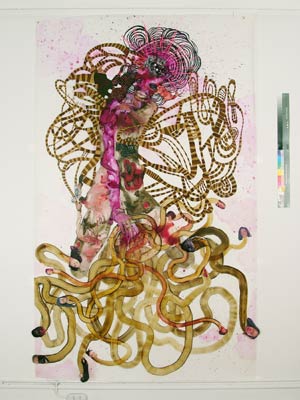Wangechi Mutu’s Impossible Women and Others
Warrior Creature, Migrant Thinker

The classic fashion poses in Wangechi Mutu’s work are often instantly recognizable, as when she shows a full-length profile of a deadpan, pouting model looking over her shoulder while shielding her bare breasts in an untitled Mylar collage from 2003. Add the logo of a company that makes hosiery and you would have an advertisement. But Mutu moves in a different direction, subtracting everything from the photographic image but the eyes, ears, lips, arms, and breasts, and then adding things, like miniature flying woman-shaped objects with knives for hands or champagne bottles for heads. She renders large expanses of the model’s exposed flesh with shapely psychedelic stains instead of skin tones, and lets some Monarch butterflies loose before splattering the whole thing liberally with what looks like blood. This description is taken from a series of Mylar collages that Wangechi Mutu has shown at the Saatchi Gallery in London, at Sikkema Jenkins & Co. in New York’s Chelsea, and in many other galleries and group shows since her work first came to the attention of the art world in the early 2000s. On Wednesday, April 23, this enigmatic and challenging contemporary artist will lecture at UCSB’s Campbell Hall in an event sponsored by Arts & Lectures and in recognition of Mutu’s being named this semester’s Regent Lecturer in Art at UCSB. The event is co-presented by the UCSB Department of Art and the Contemporary Arts Forum.
Mutu occupies an interesting position within the emerging discourse of “latemodern” art. Her work speaks to the fragmentation of the gendered subject, and the ways in which more conventional accounts of globalization tend to reinforce the assumptions of colonialism. She elaborates an aesthetic that embodies Toni Morrison’s idea of observing Africanism-analyzing and reporting the impact of racism not only on the oppressed, but on those who hold racist beliefs, especially unconscious racist beliefs.
I spoke with Mutu recently from her home and studio in Bedford-Stuyvesant, Brooklyn, New York, and she explained her approach as “looking for creative solutions to the problem of representation” in relation to Africa and its peoples. In her lectures, she combines her own story of coming to be an artist with an account of the parallel developments of Western European political and colonial history. As an example of this, she cited the period of World War II, in which you have “Britain fighting an honorable war against the Nazis, and at the same time pursuing similar goals of total domination through the same violent means against the populations of their African colonies. The country’s colonial fiction becomes a kind of vicious reflection of their supposed opposite.”
Mutu’s figures are not intended to be entirely critical of their subjects. Despite the grotesquerie and willful amputation of these anomalous figures, Mutu feels pride and affection for their radical otherness, associating them with “all these inspiring women who crossed boundaries and borders to reinvent themselves as fierce warrior creatures, people like Josephine Baker, Grace Jones, and Eartha Kitt. They left their country of origin to become migrant thinkers, combating stereotypes and spreading ideas for a new self.”
One of Mutu’s most demanding series involves the collaging of medical illustrations. These works, which have found titles taken from the illustrations they partly efface, are called things like “Uterine Catarrh” and “Indurated Ulcers of the Cervix.” In them, Mutu superimposes the clipped lips and eyes of fashion models over the medical illustrations and puts the whole thing under a fuzzy, glittery halo of natural African hair. I asked Mutu how people react to her work when she shows it in public; she said that openings are particularly amusing to her. “I always laugh when people come up to me and talk about how beautiful and strong these women are. It’s not like I don’t know there is a monstrous aspect to them. I mean, if somehow one of my figures were to approach you, you would cross the street quick.”
Recently, Mutu has embraced several other media, including watercolor, video, and site-specific work. Her most ambitious installation to date was at New York’s Salon 94 in May 2006, when she opened “Exhuming Gluttony: A Lover’s Requiem.” With some assistance from internationally known architect David Adjaye, but primarily on her own, Mutu transformed this space inside the Upper East Side townhouse home of art patrons Jeanne Greenberg Rohatyn and Nicolas Rohatyn into a chaotic, strong-smelling grotto displaying the remnants of some inexplicable feast. From the bullet holes in the walls, to the hanging animal pelts, to the jungle of wine bottles suspended from the ceiling like stalactites, “Exhuming Gluttony” radiates Mutu’s characteristic combinations of decay and excess, brooding malevolence and swaggering levity. Her lecture at UCSB is sure to provide just such an equivocal feast for all the jungle punks and warrior princesses who come to hear her.
4•1•1
Wangechi Mutu will speak and share her work at UCSB’s Campbell Hall on Wednesday, April 23, at 8 p.m. For more information, call 893-3535 or visit artsandlectures.ucsb.edu. This event is free.



